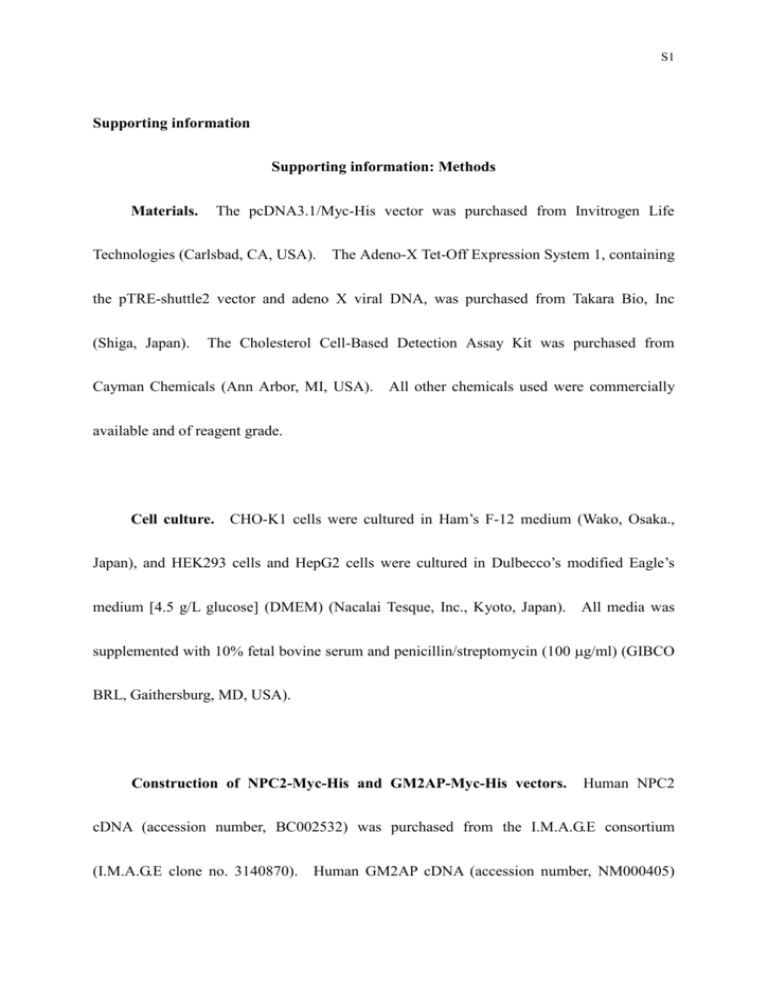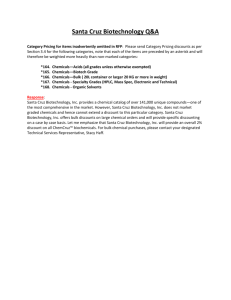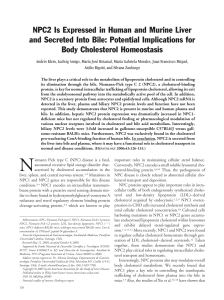HEP_24772_sm_SuppInfo
advertisement

S1 Supporting information Supporting information: Methods Materials. The pcDNA3.1/Myc-His vector was purchased from Invitrogen Life Technologies (Carlsbad, CA, USA). The Adeno-X Tet-Off Expression System 1, containing the pTRE-shuttle2 vector and adeno X viral DNA, was purchased from Takara Bio, Inc (Shiga, Japan). The Cholesterol Cell-Based Detection Assay Kit was purchased from Cayman Chemicals (Ann Arbor, MI, USA). All other chemicals used were commercially available and of reagent grade. Cell culture. CHO-K1 cells were cultured in Ham’s F-12 medium (Wako, Osaka., Japan), and HEK293 cells and HepG2 cells were cultured in Dulbecco’s modified Eagle’s medium [4.5 g/L glucose] (DMEM) (Nacalai Tesque, Inc., Kyoto, Japan). All media was supplemented with 10% fetal bovine serum and penicillin/streptomycin (100 g/ml) (GIBCO BRL, Gaithersburg, MD, USA). Construction of NPC2-Myc-His and GM2AP-Myc-His vectors. Human NPC2 cDNA (accession number, BC002532) was purchased from the I.M.A.G.E consortium (I.M.A.G.E clone no. 3140870). Human GM2AP cDNA (accession number, NM000405) S2 was amplified by PCR from total RNA of HepG2 cells. Subsequently, NPC2 and GM2AP cDNAs were inserted into pcDNA3.1/Myc-His vector plasmids to express each cDNA with an attached Myc tag sequence (EQKLISEQDL) and a 6×His tag sequence at the 3´-end. The following sense and anti-sense primers were used to construct each mutant NPC2-expressing vector: D72A (215A>c) 5´-CATTCCTGAGCCTGcTGGTTGTAAGAGTGG-3´; (sense antisense primer, primer, 5´-CCACTCTTACAACCAgCAGGCTCAGGAATG-3´); N58Q (172A>c and 174T>g) (sense primer, 5´-CAGTCTACAGCGTCcAgGTCACCTTCACCAGC-3´; antisense primer, 5´-GCTGGTGAAGGTGACcTgGACGCTGTAAGACTG-3´); and N135Q (403A>c and 405C>g) (sense primer, 5´-CTTCAGGATGACAAAcAgCAAAGTCTCTTCTGC-3´; antisense primer, 5´-GCAGAAGAGACTTTGcTgTTTGTCATCCTGAAG-3´). Immunoblot analysis. Target cDNA was introduced into cultured cells grown to approximately 70% confluence by transfection (for the expression vector) or infection (for the adenoviruses). Twenty-four hours after introducing each cDNA, the cells and the corresponding culture media were harvested separately. Media from adenovirus-infected cells were concentrated using Centricon YM-10 centrifuge filters (Millipore Corporation, Billerica, MA, USA). Cell pellets were lysed with Ripa buffer (0.1% SDS, 0.5% S3 deoxycholate and 1% Nonidet P-40). The protein concentrations were determined by the Lowry method (1) using bovine serum albumin (BSA) as a standard. Total cell lysate and concentrated media diluted with 2×SDS loading buffer were subjected to immunoblot analysis as described previously (2, 3). In order to separate each protein, 12.5% SDS-polyacrylamide gels were used for the detection of NPC2, GM2AP, cathepsin D and -tubulin and 7% gels were used for the detection of NPC1L1. Molecular weights were determined using a prestained protein marker (New England BioLabs, Bevery, MA, USA). The primary antibodies used for experiments were as follows: rabbit anti-His (BioVision , Mountain View, CA, USA) for the detection of the His tag (used at a 1:5000 dilution), mouse anti-Myc (Roche Applied Science, Indianapolis, IN, USA) for the detection of the Myc tag (1:1000), rabbit anti-HA (Santa Cruz Biotechnology, Inc., Santa Cruz, CA, USA) for the detection of the HA tag (1:1000), rabbit anti-NPC1L1 (Cayman Chemicals, Ann Arbor, MI, USA) (1:200), rabbit anti-NPC2 (Santa Cruz Biotechnology, Inc.) (1:200), goat anti-cathepsin D (Santa Cruz Biotechnology, Inc.) (1:200), rabbit anti-NPC1 (GeneTex Inc, Irvine, CA, USA) (1:500), and rabbit anti--tubulin (Cayman Chemicals) (1:1000). For detection, the membrane was incubated for 1 hour at room temperature with a 1:5000 dilution of horseradish peroxidase-labeled secondary antibody [anti-mouse (GE Healthcare, Buckinghamshire, UK), anti-rabbit (GE Healthcare) or anti-goat (Santa Cruz Biotechnology, S4 Inc.) IgG] in TBS-T containing 0.1% BSA. Peroxidase activity was assessed using the ECL Plus Western Detection System (GE Healthcare) with a luminescent image analyzer (Bio-Rad Laboratories, Tokyo, Japan). Co-immunoprecipitation Cell lysates from CHO-K1 cells infected with the indicated adenoviruses were rotated overnight at 4°C with 4 g of mouse anti-Myc antibody or 4 g of goat anti-HA antibody (Novus Biologicals, Inc., Littleton, CO, USA). Twenty microliters of a 50% slurry of washed Bio-Adembeads Protein G (Ademtech, Pessac, France) was added and the samples were rotated slowly at 4°C for an additional 3 hours. Beads were collected magnetically, washed with Ripa buffer at least five times, and incubated at 37°C for 30 minutes with SDS loading buffer containing dithiothreitol. The samples were centrifuged briefly and the supernatants were analyzed by immunoblot analysis. Quantitative real-time PCR. To determine the mRNA levels of NPC2 and NPC1L1, cells were harvested in RNA-Solv reagent (OMEGA bio-tek, Inc. Lilburn, GA, USA) and prepared RNA was reverse-transcribed with ReverTra Ace (Toyobo, Osaka, Japan). Quantitative real-time PCR was then performed, as described previously (4, 5). Primers were used as follows: NPC2 sense sequence (5´-ACAGCGTCAATGTCACCTTC-3´), NPC2 S5 antisense sequence (5´-CATCCTGAAGTTGCCACTCCAC-3´), NPC1L1 sense sequence (5´-GGTATCACTGGAAGCGAGTC-3´), NPC1L1 -actin (5´-AGGTAGAAGGTGGAGTCGAG-3´), (5´-CCGGAAGGAAAACTGACAGC-3´) and -actin antisense sequence sense sequence antisense sequence (5´-GTGGTGGTGAAGCTGTAGCC-3´). Glycosidase digestions. Twenty micrograms of protein from cellular extracts or 10 l of concentrated media prepared as described above were digested using Endo H or PNGase F according to the manufacturer’s instructions (New England Biolabs). Immunohistochemical staining. HepG2 cells at 70% confluence cultured on 35 mm glass dishes were transfected with the NPC1L1-HA expression vector. After 24 hours, cells were left untreated or were treated with MG132 (10 M) for 6 hours and were subsequently washed with phosphate buffered saline (PBS) and fixed with Bouin’s fixative for 1 hour at room temperature. Proteins were detected with the following antibodies diluted as indicated in PBS containing 0.1% BSA: rabbit anti NPC2 (1:200), mouse anti-HA (Santa Cruz Biotechnology, Inc.) (1:100), goat anti-cathepsin D (1:100), or goat anti-calnexin (Santa Cruz Biotechnology, Inc.) (1:100). Secondary antibodies (diluted 1:250 in PBS containing 0.1% S6 BSA) were Alexa Fluor 488 donkey anti-rabbit IgG, Alexa Fluor 647 donkey anti-mouse IgG and Alexa Fluor 546 donkey anti-goat IgG (Molecular Probes, Eugene, OR, USA) for the immunodetection of NPC2, NPC1L1-HA, and cathepsin D and calnexin, respectively. Cells were analyzed by confocal microscopy (Olympus, Tokyo, Japan). Transfection of siNPC1L1 into HepG2 cells. RNAi studies were carried out as reported previously (4, 5) in HepG2 cells in order to determine the effect of NPC1L1 knockdown on the expression of endogenous NPC2. DMEM to a density of 2.0 × 105 cells/ml. HepG2 cells were suspended in Approximately 20 pmol/well of NPC1L1 siRNA (5´-CCAGCUACAUUGUCAUAUUTT-3´) or a control siRNA designed not to interfere with any human genes (Sigma Aldrich, Inc., St Louis, MO, USA) was added to each 35 mm dish in a volume of 800 l of DMEM. Twelve microliters of Lipofectamin RNAiMAX (Invitrogen Life Technologies) was then added to each dish containing the diluted siRNA molecule. After incubation for 20 minutes at room temperature, 4 ml of cell dilution was added to each dish. After 2 days of incubation, cells were harvested and the mRNA and protein levels of NPC1L1 and NPC2 were determined by quantitative real-time PCR and immunoblot analysis, respectively. S7 Purification of recombinant NPC2. In order to purify each NPC2-Myc-His protein [wild-type (WT) and D72A mutant protein], Ad-NPC2-Myc-His and Ad-tTA were used to infect HEK293 cells grown on 10 cm dishes. The next day, the culture media was harvested and filtered through a 0.22 m syringe filter. Conditioned media samples were concentrated using Centriprep YM-10 concentrators (Millipore Corporation, Billerica, MA, USA) and bound to 0.1 g of IMAC Ni-charged resin (Bio-Rad Laboratories) for 2 hours at 4°C under gently rotation. The mixture was then loaded onto an appropriately-sized column, which was washed with five column volumes of washing buffer (50 mM sodium phosphate, 300 mM NaCl and 10 mM imidazole adjusted to pH 8.0). Elution of each type of NPC2-Myc-His protein was carried out using two column volumes of elution buffer (washing buffer containing 500 mM imidazole adjusted to pH 8.0). The eluate was concentrated and separated from imidazole by centrifugation with a Centricon YM10 centrifuge filter (Millipore Corporation). The samples were then precipitated with acetone in order to remove lipids from NPC2-Myc-His proteins. The concentrations of the recombinant NPC2 proteins were determined by the Lowry method (1) using BSA as a standard. S8 References 1. Lowry OH, Rosebrough NJ, Farr AL, Randall RJ. Protein measurement with the Folin phenol reagent. J Biol Chem 1951;193:265-275. 2. Matsuo H, Takada T, Ichida K, Nakamura T, Nakayama A, Ikebuchi Y, Ito K, et al. Common defects of ABCG2, a high-capacity urate exporter, cause gout: a function-based genetic analysis in a Japanese population. Sci Transl Med 2009;1:5ra11. 3. Yoshikado T, Takada T, Yamamoto T, Yamaji H, Ito K, Santa T, Yokota H, et al. Itraconazole-induced cholestasis: involvement of the inhibition of bile canalicular phospholipid translocator MDR3/ABCB4. Mol Pharmacol 2011;79:241-250. 4. Iwayanagi Y, Takada T, Suzuki H. HNF4alpha is a Crucial Modulator of the Cholesterol-Dependent Regulation of NPC1L1. Pharm Res 2008;25:1134-1141. 5. Iwayanagi Y, Takada T, Tomura F, Yamanashi Y, Terada T, Inui K, Suzuki H. Human NPC1L1 expression is positively regulated by PPARalpha. Pharm Res 2011;28:405-412.





![Relativistic_KE[1]](http://s2.studylib.net/store/data/005627416_1-a2634484541e239b68eb98cf7f28db4c-300x300.png)
